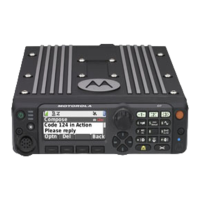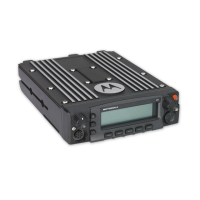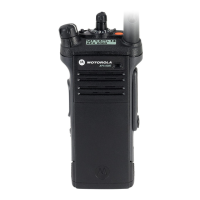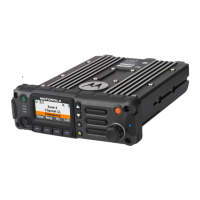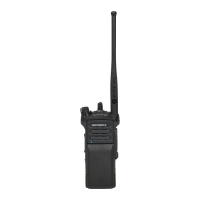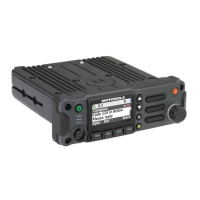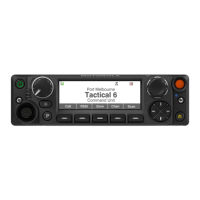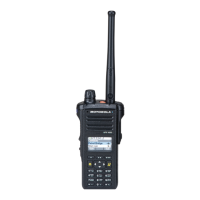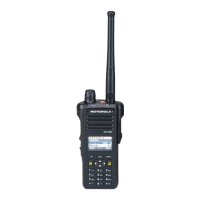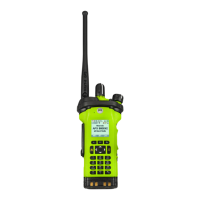Theory of Operation: Controller 3-55
3.2.6.3.1 Boost Lighting Controller/ Lighting Controller
VOCON Board MNCN6200
(Only for APX 7000 Dual-Display Version):
The boost lighting controller, U2203, provides backlight functionality for the main color QVGA
display, and the multi-colors on the keypad.
The QVGA display has 5 LEDs connected in series, and thus needs a higher voltage to illuminate
the LEDs. The voltage output, VCC_SW_20V, going through resistor R2225 generates a 17 volt
output boost supply for the display LEDs. The cathode output (negative) of the LEDs is fed back into
the lighting controller through resistor R2229. The lighting controller contains a current DAC to
control the current and for proper dimming of the LEDs.
The keypad backlighting uses 10 white LEDs and 8 tri-color Red, Green, Amber (RGA) LEDs for
illumination. The RGA tri-color LEDs are connected in parallel to the boost lighting controller while
the white LEDs are connected to the secondary lighting controller. The RGA LEDs are supplied by
the VDD_LC supply and controlled by boost lighting controller through resistors R2222, R2223, and
R2224 for Red, Green, and Amber LEDs, respectively.
VOCON Board MNCN6202
:
The lighting controller, U2203, provides backlight functionality for the main color QVGA display, and
the multi-colors on the keypad.
The QVGA display has 5 LEDs connected in parallel, and thus needs 5V voltage from VCC_SW_5
connected to the input (positive) of the LED for illumination. The cathode output (negative) of the
LEDs is fed back into the lighting controller through resistor R2229, R2335, R2336, R2337 and
R2338. The lighting controller contains a current DAC to control the current and for proper dimming
of the LEDs.
The keypad backlighting uses 10 white LEDs and 8 tri-color Red, Green, Amber (RGA) LEDs for
illumination. The RGA tri-color LEDs are connected in parallel to the lighting controller while the
white LEDs are connected to the secondary lighting controller. The RGA LEDs are supplied by the
VDD_LC supply and controlled by boost lighting controller through resistors R2222, R2223, and
R2224 for Red, Green, and Amber LEDs, respectively.
3.2.6.3.2 Secondary Lighting Controller
As previously mentioned the secondary lighting controller provides illumination to the top display
backlight, keypad white backlight, and Tx/Rx indicator lamp. This lighting controller device uses a
PWM output to control the dimming modes of operation for the LEDs. The device is controlled
through the I2C interface, however, the I2C interface require an input high voltage between
3 V – 5.5 V, thus the level translator (U2202) is added to the lines to upconvert the high voltage.
Figure 3-44 shows the major connection scheme to this secondary lighting controller. As mentioned
in the boost lighting controller section, the 10 white parallel keypad backlight LEDs are controlled
through this device. Due to the higher current drain required for the keypad backlight LEDs, 2 PWM
outputs as are needed to control the white keypad LEDs. The top display has 2 parallel side firing
white LEDs and 2 parallel side firing red and green bi-color LEDs, which are also controlled through
the secondary lighting controller. The white, green, and red top display LEDs are connected to the
lighting controller PWM outputs through ESD filter inductors L2204, L2203, L2202, respectively. The
TX/RX status indicator LED uses the same tri-color red, green, amber (RGA) LED that is placed on
the keypad. The status indicator LED outputs are connected to the PWM outputs of the lighting
controller through resistive components R2213, R2214, and R2215.
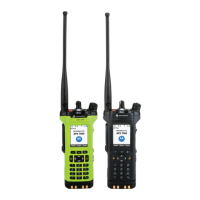
